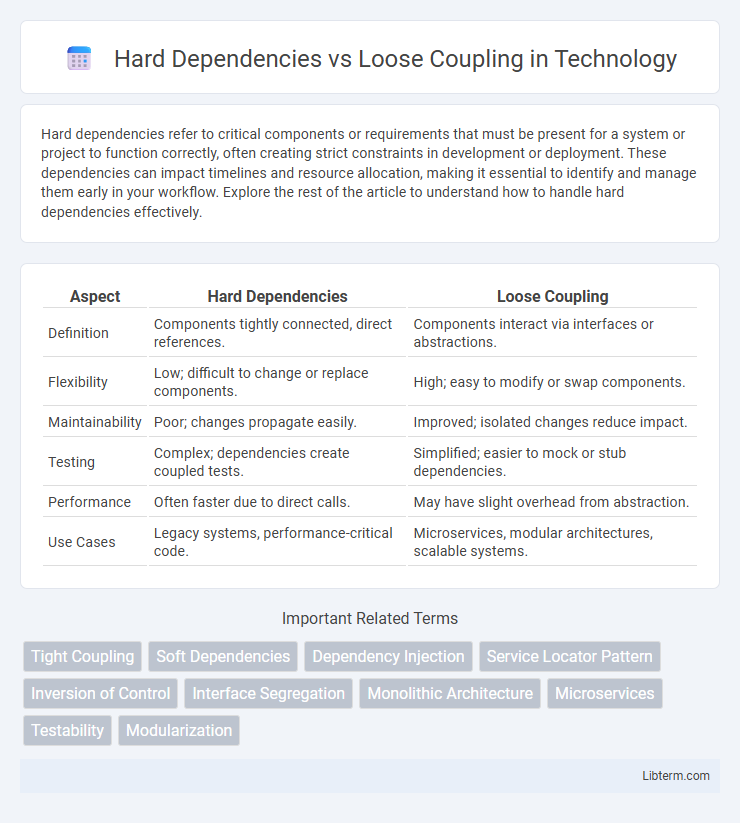Hard dependencies refer to critical components or requirements that must be present for a system or project to function correctly, often creating strict constraints in development or deployment. These dependencies can impact timelines and resource allocation, making it essential to identify and manage them early in your workflow. Explore the rest of the article to understand how to handle hard dependencies effectively.
Table of Comparison
| Aspect | Hard Dependencies | Loose Coupling |
|---|---|---|
| Definition | Components tightly connected, direct references. | Components interact via interfaces or abstractions. |
| Flexibility | Low; difficult to change or replace components. | High; easy to modify or swap components. |
| Maintainability | Poor; changes propagate easily. | Improved; isolated changes reduce impact. |
| Testing | Complex; dependencies create coupled tests. | Simplified; easier to mock or stub dependencies. |
| Performance | Often faster due to direct calls. | May have slight overhead from abstraction. |
| Use Cases | Legacy systems, performance-critical code. | Microservices, modular architectures, scalable systems. |
Understanding Hard Dependencies
Hard dependencies occur when components in a system are tightly bound, requiring direct knowledge of each other's implementations, which reduces flexibility and increases maintenance complexity. Systems with hard dependencies often experience challenges in scaling or adapting to change due to the rigid connections between modules. Understanding hard dependencies is crucial for identifying opportunities to refactor code towards more modular and maintainable architectures.
What is Loose Coupling?
Loose coupling is a design principle in software engineering where components or modules interact with each other through well-defined interfaces, minimizing interdependencies and allowing for greater flexibility and scalability. It enhances maintainability by enabling changes in one module without significantly impacting others, promoting modularity and easing integration. Systems designed with loose coupling support easier testing, parallel development, and adaptability to evolving requirements.
Key Differences Between Hard Dependencies and Loose Coupling
Hard dependencies tightly bind components, making systems rigid and challenging to modify or scale. Loose coupling promotes modularity by minimizing direct dependencies, enabling easier maintenance and flexibility in integrating changes. The key difference lies in the degree of component interdependence, with hard dependencies reducing adaptability and loose coupling enhancing system resilience and extensibility.
Advantages of Hard Dependencies
Hard dependencies provide clear and direct connections between components, ensuring stability and predictability in system behavior. They simplify debugging and maintenance by making the relationships explicit, which can enhance performance due to tighter integration. This approach is beneficial in scenarios requiring rigorous consistency and minimal runtime overhead.
Benefits of Loose Coupling
Loose coupling enhances software maintainability by minimizing interdependencies, allowing components to evolve independently without impacting the entire system. It improves scalability and flexibility, enabling easier integration of new features or replacement of modules with minimal disruptions. Reduced risk of cascading failures and simplified testing processes are also significant benefits, leading to more robust and resilient applications.
Risks of Tight Coupling in Software Design
Tight coupling in software design increases system fragility by creating strong interdependencies between components, making maintenance and updates difficult and error-prone. It limits reusability and scalability due to the rigid connections that require simultaneous changes across multiple modules. This risk magnifies the potential for cascading failures, where a defect in one component can propagate throughout the entire system, reducing overall reliability.
Examples of Hard Dependencies in Real Projects
Hard dependencies in real projects often manifest when modules or components are tightly integrated, requiring direct access to each other's internal structures or services. For instance, a payment processing system directly calling a specific third-party API without abstraction creates a hard dependency, making changes or replacements challenging. Another example is a microservice relying on a fixed database schema without an interface layer, causing high coupling that reduces flexibility and maintainability.
Techniques for Achieving Loose Coupling
Techniques for achieving loose coupling include the use of interfaces and abstract classes to define contracts between components, enabling independent development and modification. Dependency Injection frameworks facilitate the inversion of control, allowing components to receive their dependencies from external sources rather than creating them internally. Event-driven architecture and message queues decouple system components by enabling asynchronous communication, reducing direct dependencies and increasing scalability.
Best Practices for Dependency Management
Hard dependencies create tight coupling between components, making systems rigid and difficult to maintain or scale. Leveraging loose coupling through dependency injection and modular design promotes flexibility, easier testing, and enhanced code reuse. Best practices emphasize minimizing direct dependencies, using interfaces or abstractions, and adopting service locators or dependency inversion principles to improve maintainability and evolution of software systems.
Choosing the Right Approach: When to Use Hard Dependencies vs Loose Coupling
Hard dependencies ensure tight integration and straightforward management of critical components, ideal for systems requiring high performance and strict consistency. Loose coupling enhances flexibility and scalability by minimizing inter-component reliance, making it suitable for distributed architectures and evolving applications. Selecting between hard dependencies and loose coupling depends on project complexity, deployment environment, and the need for system adaptability versus predictability.
Hard Dependencies Infographic

 libterm.com
libterm.com